Decisive Edge Newsletter | Land | March 2023
Newsletter Sponsors:
Private venture weapon systems – the recipe for success
In the land systems sector there have always been contractors who invested their own money in private venture (PV) research and development with the aim of producing new equipment for home and/or export markets.

Explore armored vehicles and turret systems of Otokar, the global land systems manufacturer.
This can range from small subsystems up to a complete armoured fighting vehicle (AFV) or weapon system. While some of these have been a major success story, others have fallen by the wayside and disappeared without trace.
The art of a successful PV development is to carefully listen to potential end users’ requirements and design a piece of equipment that has some flexibility to meet different customer needs.
Where possible it should also have some local content, and if the order is big enough, local assembly or production.
European contractors should also ensure that no part of the AFV or weapon system includes elements that are subject to the US International Traffic in Arms Regulations (ITAR).

Tried, tested and proven armoured vehicle attachments - Helping Armed Forces to Defend, Move and Fight.
In recent years one of the most successful PV weapon systems has been the Vickers Shipbuilding & Engineering (now BAE Systems) 155mm/39cal Lightweight Howitzer which was originally developed to meet potential US requirements as a replacement for the heavier 155mm M198 towed artillery.
Following extensive trials this was adopted by the US Army and Marine Corps as the M777, with some key parts production and final assembly taking place in the US.

Above: M777 real-time 3D model supplied by MVRsimulation. View source.
This included the barrel, which is made at Watervliet Arsenal and has the same ballistics as that used on the M109 tracked self-propelled (SP) artillery system operated by the US and many other countries.
The M777 was subsequently adopted by Australia, Canada and India and more recently the US has supplied a quantity to the Ukraine, it was never acquired by the British Army.
Another recent export success is the German KMW Remote Controlled Howitzer 155 (RCH) which was developed almost 20 years ago as a PV with the first example based on a surplus M270 Multiple Launch Rocket System (MLRS) chassis.
More recently it has undergone further development and uses the Boxer 8x8 chassis with the 155mm/52cal ordnance being the same as that installed in the KMW PzH 2000 tracked SP artillery system deployed by the German Army and others.
RCH-155 is now in production for Ukraine which will get 18 units and is a potential contender for a German Army SPH to complement the PzH 2000; the RCH-155 will have greater strategic mobility as it is lighter and wheeled. Its main drawback is that it carries only 30 155mm projectiles and charges compared with 60 for the PzH 2000.
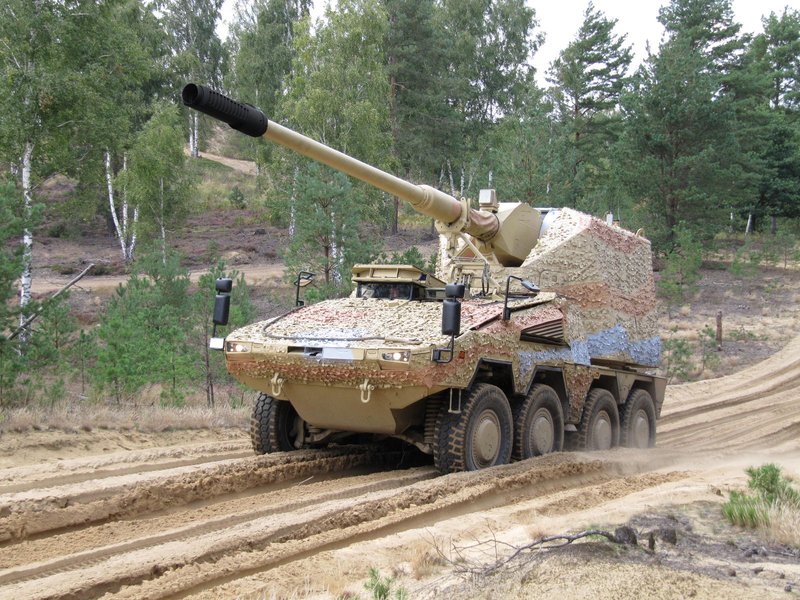
Above: A KMW RCH-155 based on a Boxer chassis in travelling configuration with the ordnance in travelling lock. (Photo: KMW)
However contractors’ PV developments do not always enter service with the host country in the short term.
The now Thales 120mm 2R 2M recoiling mortar system was first shown as far back as 1993 and was adopted by five countries before finally being acquired by the French Army which will take delivery of first production systems installed in the new Griffon 6x6 armoured personnel carrier (APC) in 2024.
One of the latest PV vehicles to enter production is the Rheinmetall Lynx infantry fighting vehicle (IFV) with the launch customer being Hungary.
The first batch is built on a German production line followed by local manufacture In Hungary, with some key subsystems still supplied from Germany.
Lynx is de-risked by using many proven Rheinmetall subsystems including the active protection system, sights, 30mm dual-feed cannon and smoke grenade launchers.
Turkish company Otokar has built large numbers of AFVs for export with many of these being developed as PVs but using proven commercial components.
The company’s Arma has been developed in 6x6 and 8x8 versions which share many common components making for easier integrated logistic support (ILS) as well as training.
These can be fitted with Otokar-designed turrets or other options such as the John Cockerill Defense C3000 series.
More recently, Otokar developed the Rabdan 8x8 to meet the requirements of the United Arab Emirates with 400 already supplied.
These have been fitted with turrets removed from the UAE’s Russian supplied BMP-3 IFVs which are armed with a 100mm low pressure gun, 30mm coaxial cannon and a 7.62mm MG.
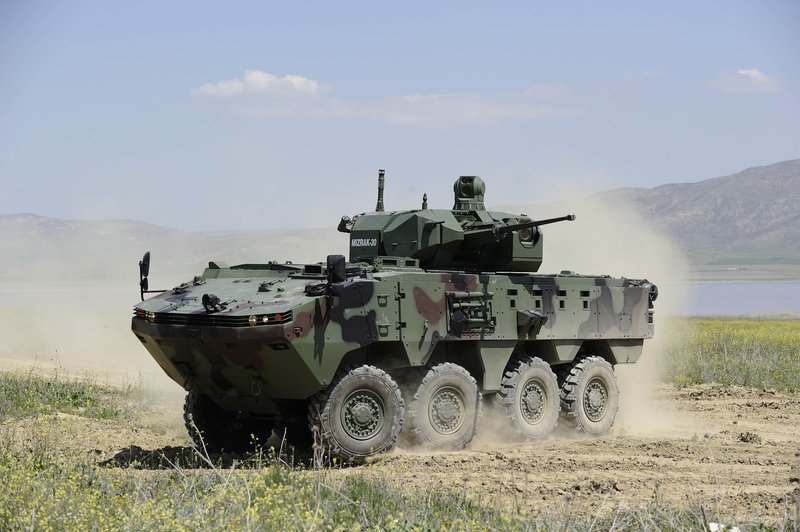
Above: The 8x8 Otokar Arma 8x8 in IFV configuration fitted with the company’s Mizrak-30 turret. (Photo: Otokar)
On the subsystem level Belgian company John Cockerill Defence has enjoyed major export success with its C3000 series of turrets with almost 1,000 already sold to Saudi Arabia (for installation on General Dynamics Land Systems LAV 700s) and more recently Indonesia (on the FNSS Kaplan medium tank).
A key feature of the C3000 family of turrets is modularity as they can be fitted with a wide range of weapons as well as flexibility at subsystem level including the level of ballistic protection and the sighting system.
Typical weapons fit include the Northrop Grumman 30mm MK44 dual-feed cannon or the John Cockerill Defence 105mm high-pressure rifled gun which is fed by a bustle mounted automatic loader.
China brings new heavy IFV to market
China North Industries Corporation (NORINCO) is now marketing the VN20 heavy infantry fighting vehicle (HIFV) which uses components from the VT4 main battle tank (MBT).
The first example is fitted with a manned turret armed with a 100mm low pressure gun with 34 rounds of ammunition, 30mm coaxial dual feed cannon with 500 rounds and a 7.62mm coaxial machine gun (MG).
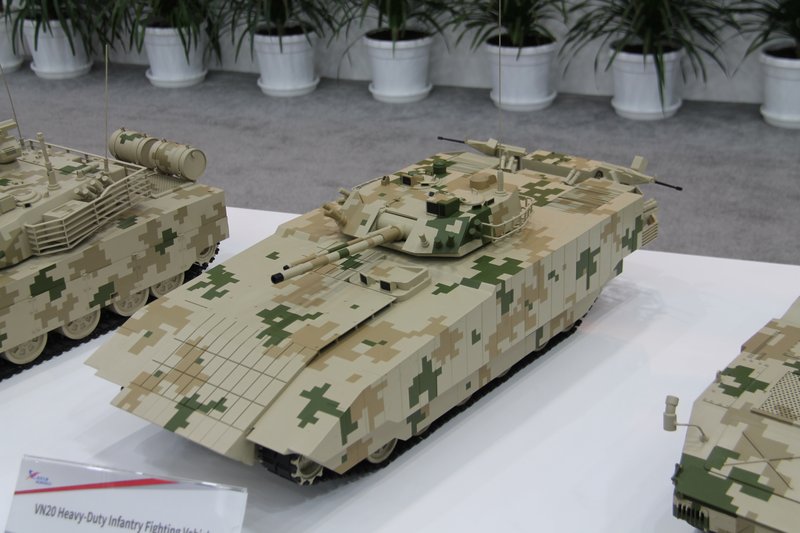
Above: A scale model of NORINCO’s VN20 HIFV fitted with a two-person turret armed with a 100mm main gun. Note explosive-reactive armour fitted over the frontal arc. (Photo: author)
According to NORINCO, the VN20 has a digital fire control system with commander and gunner each having stabilised day/night sights incorporating a laser rangefinder.
This allows for hunter/killer target engagements to take place in which the commander acquires the target and (if confirmed as hostile) hands over to the gunner who carries out the engagement.
The VN20 is also armed with Red Arrow 12E antitank guided weapons which allow targets to be engaged out to a range of 4,000m. This missile is fitted with a dual high-explosive antitank warhead which it is claimed will penetrate explosive-reactive armour (ERA).
The turret is very similar to that fitted to the NORINCO VN11 IFV which is currently deployed by the Peoples Liberation Army under the designation ZBD-04. It is essentially an upgraded version of the turret installed on the Russian BMP-3 IFV.
Images also show that the turret of the VN20 HIFV can be fitted with a roof mounted remote weapon station.
A scale model of the VN20 shown at IDEX 2023 last month was also fitted with two RWS, mounted one either side at the rear of the hull.
These are retracted when travelling and slide out horizontally when required and cover the vulnerable rear arc from close in attack.
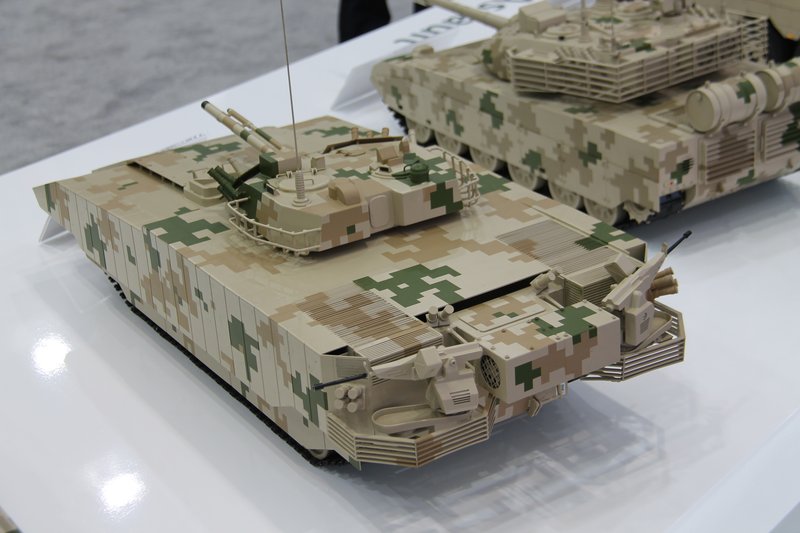
Above: A rear view of the VN20 clearly showing RWS installed on either side of the hull which when deployed provide close-in protection over the rear arc. (Photo: author)
In addition to commander, gunner and driver there is room for eight dismounts seated in the rear troop compartment.
With a gross vehicle weight of 55t the 1,250hp diesel engine coupled to an automatic transmission gives a good power-to-weight ratio of 22.72hp/t.
Maximum road speed is quoted as 65 km/h and a maximum cruising range of up to 450 km.
NORINCO is claiming a very high level of protection for the VN20 HIFV with ballistic protection being to STANAG 4569 Level + over the frontal arc, STANAG 4569 Level 6 over the sides and mine protection to STANAG 4569 Level 4a/4b.
This is thanks to a mixture ‘advanced armour’ materials but also ERA and bar/slat armour.
According to NORINCO standard equipment on the VN20 includes banks of electrically operated smoke grenade launchers which could be linked to laser detectors.
It also features an electronic architecture (with all crew members provided with their own terminals), a battle management system and satellite based navigation system.
Cameras provide situational awareness through 360 degrees and an NBC and fire detection and suppression system is fitted as standard.
UAE’s Calidus broadens mission set for MCAV APC, readies Wahash IFV for production
Abu Dhabi-based Calidus has developed a new version of its Multirole Combat Armoured Vehicle (MCAV) designated the MCAV 005.
This is based on a modified 4x4 chassis with diesel power pack at the front, enclosed four-door cab in the middle and a flat bed for cargo or mission equipment at the rear.
MCAV 005 has a gross vehicle weight (GVW) of 9.5t of which 1.98t is payload. The vehicle is powered by a 330hp diesel which gives a maximum road speed of up to 110km/h and a range of 700km.
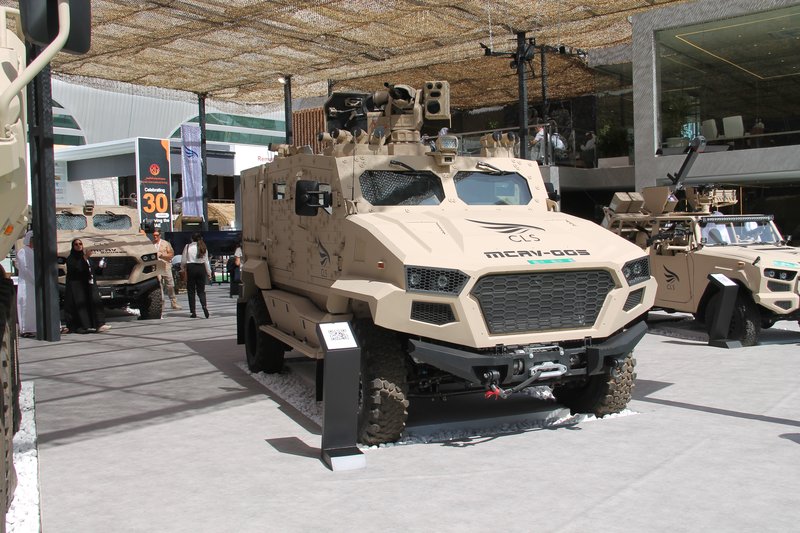
Above: The MCAV 005 in four-door configuration with rear load area, front-mounted winch and roof-mounted remote weapon station. (Photo: author)
The standard version has a 12V electrical system but as an option it can be fitted with a 24V mission equipment and battery pack.
Ballistic protection is to STANAG 4569 Level 3 while landmine protection level is to STANAG Level 3a and 3b.
As usual there are a number of options including roof-mounted remote weapons, navigation systems and internal and external communications.
The company declined to say what chassis is used, but sources indicated that it was a Ford 550 series and that production was already under way with over 300 completed out of an order for some 1,200 units in armoured personnel carrier (APC) configuration.
Meanwhile development of the Wahash 8x8 infantry fighting vehicle (IFV) has been completed and in addition to two prototypes a batch of pre-production vehicles has been completed so production can commence as soon as a contract is placed.
With a typical GVW of up to 34t, the allowable payload is nearly 11t. In IFV configuration it would typically have a crew of three consisting of commander, gunner and driver plus eight dismounts.
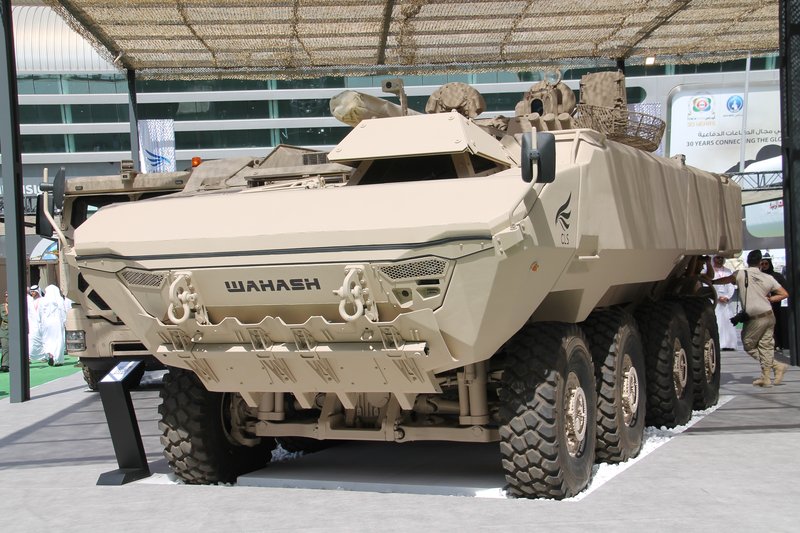
Above: The Wahash 8x8 in IFV configuration fitted with the complete turret of the Russian BMP-3. (Photo: author)
The version shown at IDEX 2023 last month was fitted with the complete turret from the Russian BMP-3 IFV armed with a 100mm low-pressure gun, 30mm dual feed co-axial cannon and 7.62mm coaxial MG.
The UAE took delivery of a large number of BMP-3s but the turrets from many of these have been removed and fitted to the Rabdan 8x8 which is now deployed by the country’s armed forces.
According to the prime contractor Wahash has a high level of protection for a vehicle in its weight class with STANAG 4569 Level 4 on the hull and STANAG 4569 Level 4a and 4b against mines.
Unlike a number of other 8x8 platforms, Wahash is fully amphibious, being propelled in the water at a maximum speed of up to 8km/h by two propellers situated one either side at the rear.
The Wahash also features a flexible generic vehicle architecture for integration of subsystems specified by the end user.

UAE looks ahead to tank and IFV modernisation
Screened from a news cycle dominated by European procurement programmes, Ukraine donations and JLTV upsets, the UAE looks quietly poised to kickstart its own modernisation of armoured vehicles. Analysis by Sam Hart.
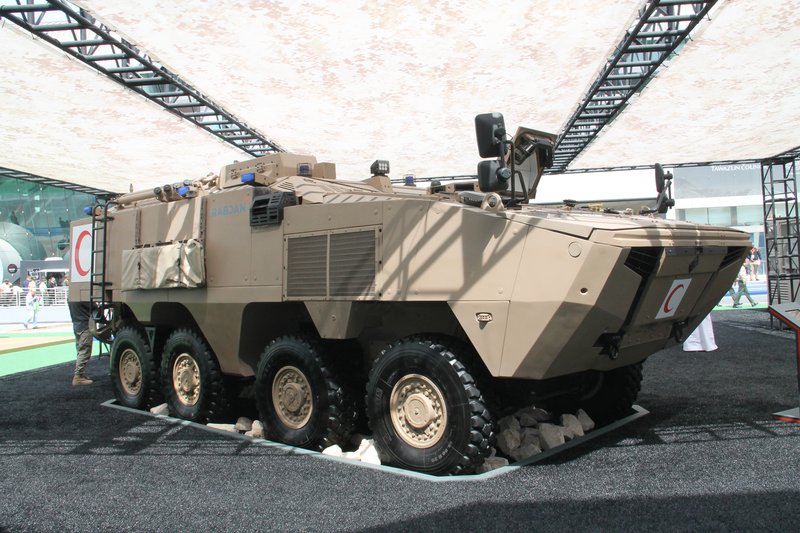
Above: Otokar displayed a new variant of the 8x8 Rabdan at IDEX, with a higher roof line suitable for ambulance and command post variants. (Photo: Christopher F Foss)
Nearly 20 years old and rapidly approaching their out-of-service date, the UAE’s 300 Leclerc main battle tanks (MBTs) appear to be receiving a new lease of life at the hands of an estimated $432 million upgrade programme with French manufacturer Nexter.
With a still-hot French modification line for the domestic Leclerc XLR upgrade, the UAE is expected to benefit from a faster and cheaper delivery time than the Armée de Terre.
As France’s $1.4 million per unit programme under the SCORPION umbrella reaches full-scale production in 2024 and completes in 2029, the UAE is forecast to mirror at least some French upgrades to the Leclerc, including an FN Herstal T2B remote weapon station with 7.62mm machine gun, new side armour protection, IED jammers, an upgraded fire control system and a new commander's sight.
Accounting for a less highly modified range of upgrades than the French Leclerc XLR and the reduced costs of a pre-established production line, Defence Insight forecasts a unit cost of $1.2 million, with deliveries possible as early as 2026.
Having confirmed at IDEX 2023 the completed delivery of 400 Rabdan 8x8 and 6x6 infantry fighting vehicles to the UAE, manufacturer Otokar and its local subsidiary Al Jasoor will undoubtedly be hopeful for an expected $0.5 billion order for an additional 300 Rabdan platforms some time in the next 12 months.
Replacing legacy BMP-3 tracked IFVs, the six-wheeled and eight-wheeled Rabdans have rapidly become a one-size-fits-all for UAE armoured utility capability.
With Al Jasoor unveiling a prototype Rabdan 8x8 model featuring a higher roof line for greater internal volume since the previous order, ambulance and command post versions of the Rabdan are easily envisionable in any future procurement.
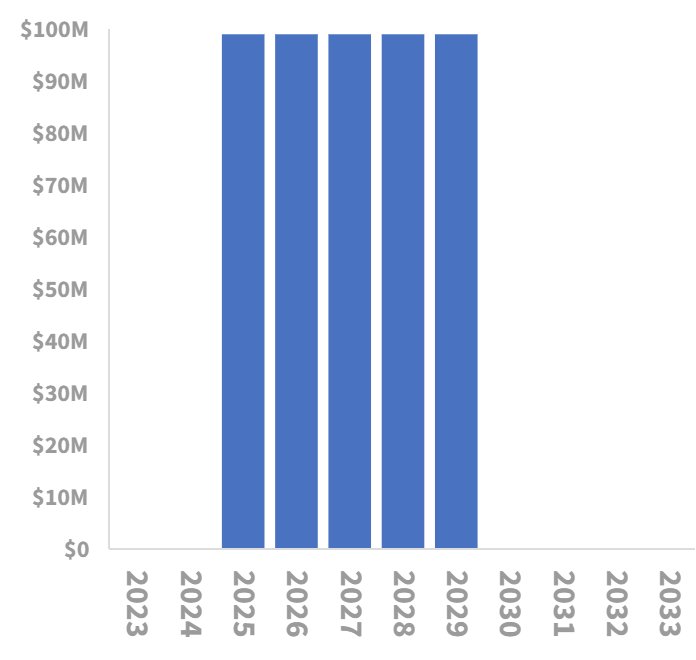
Source: Shephard Defence Insight
Forecast for an award in 2024; Defence Insight estimates first delivery in 2025, with the remainder having entered service by 2030.
Don't want to miss out on future Decisive Edge content? Make sure you are signed up to our email newsletters.












